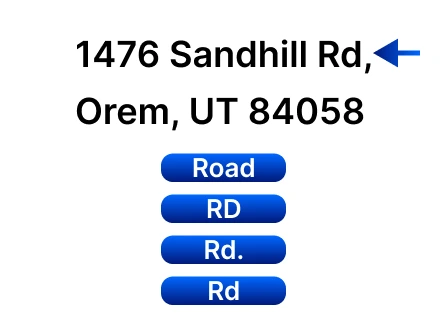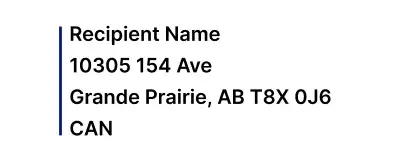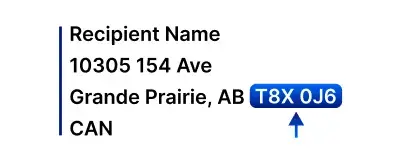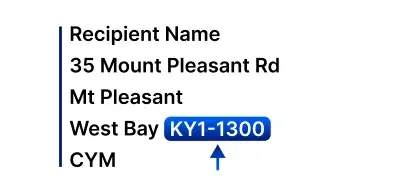Comprehensive guide to international address formats

If you’re in the United States and shipping via USPS, the international address format can generally be written as follows:
- Address line 1: The recipient’s full name
- Address line 2: The street address or PO Box
- Address line 3: The city/town, province/state
- Address line 4: The country and postal code (if you’ve got it)
Sadly, there’s no “one size fits all” approach to understanding mailing practices overseas.
However, there is a “one size fits most” approach that should significantly reduce your research-to-send time. You might even learn some fun facts along the way.
International addresses are complex. With over 200 unique address formats for all 250 countries and territories, each has its own style shaped by culture and language. Knowing these differences is vital to ensuring your mail arrives safely without any unnecessary hiccups.
Here’s the map of what (and where) we’ll be exploring concerning international addresses. We’ve included clickable shortcuts if you already know where you want to dive in:
- Address structures overview
- UPU: The international address format "authority"
- Examples of international address formats and interpreting their code
- United Kingdom correct address format example
- Japanese correct address format example
- Colombian correct address format example
- Order of address elements by country
- Normalization/standardization of address components
- Postal codes in an international context
- International postal address standards
- Best practices for addressing international mail
- FAQs
Address structures overview
Like we mentioned earlier, there’s not a “one size fits all” approach to international addresses (although that would be nice; can someone above my pay grade work on that?). However, there IS a one-size-fits-most approach, as every country contains similar parts.
Key components of address formats
Let’s look at addresses as if they’re a recipe.

Most recipes contain similar ingredients: salt and pepper, butter, eggs, milk, that make a delicious snack when all of those ingredients are mixed in the right proportions in the right order.
Emphasis on the word “most.” Some recipes are made with turnips that can only be found on the east side of Bulgaria. Go figure. Some chefs just have a more sophisticated pallet than most.
Just like recipes, international addresses typically contain similar pieces:
- Primary number - This can be a building or house number where the mail will be delivered.
- Street name - The name of the street where the house or building is located.
- Street type - What type of street are we dealing with? Is it a road? Circle? Avenue?
- City name - The locality where the street resides.
- Country - The country the address can be found in.
- Postal code - Numbers and even sometimes letters that signify a specific geographic location for mail delivery.
Variances across different regions
Even though there are similar address parts, there are also differences like foreign languages, terminology usage, abbreviations, formatting and standardizing guides, and even post carriers, and address expectations vary widely from country to country.
A few of these variances are:

- Order of components—Yes, this matters. Even if all of the parts of an address are correct and included, if they’re out of order for the region you’re shipping to, the mail carriers could misdeliver the package entirely or send it straight back as undeliverable. Unfortunately, “Oopsie, wrong address format refunds” aren’t a thing. You’re out the money and out of luck.
- Street name pre-directional—Some countries, like the United States, use pre-directionals (abbreviated compass headings) such as N, S, E, W, NE, NW, SE, and SW before listing the street name to differentiate between similarly named streets.
- Street name post-directional—Just as the prefix “post” suggests, these are abbreviated compass headings that come after the street name to differentiate between similarly-named streets.
- To abbreviate or not to abbreviate—Some countries, like the USA, allow street suffix abbreviations (such as AVE for Avenue or RD for Road). This isn’t a follow-your-heart type of science, though, and you should use the accepted regional abbreviations. However, places like France, Spain, and most of South America generally don’t use street suffix abbreviations and favor the fully spelled-out word.
- County—Larger urban areas may require the inclusion of a county or post town/township to help narrow down the precise location of where the mail or package should be delivered.
- Spelling—The spelling of different components can vary worldwide, and misspelling an address component can lead to confusion and even lost mail.
- Casing—Some countries encourage all capital letters for addressing mail (UPPERCASE LETTERS SCREAMING FOR THE WIN), whereas others prefer title casing (Like When Almost Every Word Begins With Uppercase Letters) standardization for the most efficient mail sorting and accurate delivery planning.
UPU: The international address format "authority"
With all of those variations (and more that we haven’t even begun to cover), someone or a group of someones needed to manage them and help facilitate the policies surrounding international addresses. International communication would become significantly easier because of their efforts.
Enter the Universal Postal Union (UPU), an international organization that facilitates uniform postal service policies and procedures for its member countries. Established in 1874, the UPU made the reciprocal exchange of letters possible internationally, supporting its message, “One world. One postal network.”
Additionally, the Postal Technology Center (PTC) is an operational arm working alongside the UPU to provide “secure, trusted, ‘always available’” access to global communications networks. Think of them as both tech support and quality control for the UPU.
Sounds nice, but how?!
The UPU gathers data annually from every member country and publishes it in the Postal Statistics Yearbook. Member countries submit their standards and formatting, and any member of the United Nations may become a member of the UPU. Any non-UN member country can submit a request for approval by at least two-thirds of the current UPU member countries.
The UPU currently holds 192 members, and a comprehensive list of those countries can be found here.

Here is a link to the UPU’s addressing standards and guidelines they’ve implemented worldwide. These templates can be incorporated into your software to assist you with transforming separated address ingredients (street name, building number, city, etc.) into a fully standardized and accurately formatted address for mailing and shipping purposes. However, even if you’re an expert coder with supernatural abilities, this can be an extremely time-consuming project that might still lack all of the information needed.
One thing to be wary of is that the UPU only contains the postcodes of 192 member countries. Not every country/territory is a member of and supported by the UPU. On its own site, the UPU states that there are more than 200 address formats in the world, along with 200 database structures and at least 20 language scripts used to write addresses.
That’s a lot of data, and in running our own tests alongside the information gathered from other reputable sources, we’ve found some data discrepancies. The UPU is a great place to start, but it should not be the be-all and end-all solution for verifying that your packages will get where they need to go.
An easier route to use perfectly formatted international addresses is to find a data provider that does it for you.
Smarty’s tools have built-in, preferred formatting, so that you can take confidence in your mail getting where it needs to go the first time. We have taken the UPU’s formatting and cross referenced it with other valuable and verifiable sources to make sure that the information provided in our tools is the most useful to you.
We also provide you with the address recipe in our results. This is because we understand that you might want to differ from these preferences to support your own business goals. We give you the components parsed out, as well as the suggested and preferred standard format according to the country’s guidelines and rules. That way, you can customize the address from there to meet your needs.
Let’s take a look at exactly how this happens.
Examples of international address formats and interpreting their code
Listen, we know you probably don’t want to scroll through every country’s address format right now, so we just included a few of the more popular examples.
However, if we’re totally wrong and you have at least 20 hours worth of international address format scrolling in you, here’s a link to Smarty’s international address formatting guide by continent or country. We’ll even give you bonus nuggets of delicious country information like ISO codes, urban vs. rural distribution percentages, official languages, and more!
We’re going to be using the International Street Address API to show you what the results mean and where you might want to customize on your own, but you can also try these on for size. Use the:
- Single address validation tool to verify and format 1 address at a time
- Bulk address validation tool to verify and format a list of addresses simultaneously
- Other tools found in the Live API Playground
United Kingdom correct address format example

This smashing list of UK address format examples is what we’ll use to look more into the code.
Using a typical UK address example: 5 Cherry Tree Avenue Balerno EH14 5AN Midlothian GBR. Let’s pretend we have all the pieces of an address, but we don’t know how to separate out the address lines on a piece of mail.
In the tool, you can alter the input to be freeform as one unbroken address line. If entered into the tool in this way, here’s the result our API will spit back:
[
{
"address1": "5 Cherry Tree Avenue",
"address2": "Balerno",
"address3": "EH14 5AN",
"components": {
"administrative_area": "Midlothian",
"administrative_area_iso2": "GB-MLN",
"country_iso_3": "GBR",
"locality": "Balerno",
"postal_code": "EH14 5AN",
"postal_code_short": "EH14 5AN",
"premise": "5",
"premise_number": "5",
"thoroughfare": "Cherry Tree Avenue"
},
"metadata": {
"address_format": "premise thoroughfare|locality|postal_code"
},
"analysis": {
"verification_status": "Verified",
"address_precision": "DeliveryPoint",
"max_address_precision": "DeliveryPoint",
"changes": {
"components": {
"administrative_area": "Verified-NoChange",
"administrative_area_iso2": "Added",
"country_iso_3": "Added",
"locality": "Verified-NoChange",
"postal_code": "Verified-NoChange",
"postal_code_short": "Verified-NoChange",
"premise": "Verified-NoChange",
"premise_number": "Verified-NoChange",
"thoroughfare": "Verified-SmallChange"
}
}
}
}
]
If you take note of the “components” section of the code block, you’ll see that each section of the address is broken out into what we like to call the “ingredients” of an address. The “metadata” section will show the UK’s preferred standard format that those ingredients should be placed, or the “recipe.”
The example above shows the premise, followed by a space, the thoroughfare and then the pipe (vertical line) shows that the next information set should go on a new line.
You can follow the formula all the way through to create it from scratch, or, you can reference the “address1”, “address2”, and “address3” at the top of the dataset to see how it would format on the envelope. The Royal Mail will thank you!
Note: Our API response does not show the country “GBR” on its own line because it is built to replicate what is required by the Royal Mail internally for that country. Just as you don’t put “USA” if you are from America sending mail to another United States dweller, you also wouldn’t do that in the United Kingdom.
However, since you are here, you likely want to know how to make address labels for mail internationally, and in that sense, you would include the country on the last line.
Here’s a few other examples of other postal addresses that you can fiddle with in the API that vary slightly from a typical, standard UK address.
UK address example with unites
Flat 10, 16 Sutton Plaza, Sutton SM1 4FW Surrey GBR
In the API response for this example, note that the formatting has 4 address lines because each flat number gets its own line.
Let’s mix up the order of the address components, though, because right now, the string is in order for where the pieces actually go in the recipe.
UK Address example with mixed up order of "ingredients"
Let’s say that we
were unsure of the address component order. We enter the address like this: “Flat 10, 16 Sutton
Plaza Sutton Surrey GBR SM1 4FW“.
International Address Verification is intuitive enough to know how to reorganize the information and still give us the standard formatting for this country. Our tool will return an address with this formatted response:
[
{
"address1": "Flat 10",
"address2": "16 Sutton Plaza",
"address3": "Sutton",
"address4": "SM1 4FW",
"components": {
"administrative_area": "Surrey",
"administrative_area_iso2": "GB-SRY",
"country_iso_3": "GBR",
"locality": "Sutton",
"postal_code": "SM1 4FW",
"postal_code_short": "SM1 4FW",
"premise": "16",
"premise_number": "16",
"thoroughfare": "Sutton Plaza",
"thoroughfare_name": "Sutton",
"thoroughfare_trailing_type": "Plaza",
"sub_building": "Flat 10",
"sub_building_type": "Flat",
"sub_building_number": "10"
},
"metadata": {
"address_format": "sub_building|premise thoroughfare|locality|postal_code"
},
"analysis": {
"verification_status": "Verified",
"address_precision": "DeliveryPoint",
"max_address_precision": "DeliveryPoint",
"changes": {
"components": {
"administrative_area": "Verified-NoChange",
"administrative_area_iso2": "Added",
"country_iso_3": "Added",
"locality": "Verified-NoChange",
"postal_code": "Verified-NoChange",
"postal_code_short": "Verified-NoChange",
"premise": "Verified-NoChange",
"premise_number": "Verified-NoChange",
"thoroughfare": "Verified-NoChange",
"thoroughfare_name": "Identified-ContextChange",
"thoroughfare_trailing_type": "Identified-NoChange",
"sub_building": "Verified-NoChange",
"sub_building_type": "Identified-NoChange",
"sub_building_number": "Identified-NoChange",
"sub_building_leading_type": "Identified-NoChange"
}
}
}
}
]
Notice that even though we (purposefully) input the address ingredients in the wrong order, the correct formatting is returned for your use.
This is helpful here because if you are truly out of your depth with an international address block and not sure on the order of components, you can take confidence that Smarty’s tools DO know the order.
What’s even more useful is that Smarty’s tools help this way for addresses where you might not know the language or associated characters in that country.
Let's look at Japan.
Japanese correct address format example

Japan’s address format should be written with a few things in mind. First, normally, addresses in Japan are written all in one line, beginning with the largest spatial area and ending with the smallest, and even if you didn’t know that, you’re in luck! Our tool does!
Here’s an address that might look intimidating to a non-native of Japan: ”中之島4丁目2−55大阪市 大阪府 5300005”.
How are you supposed to be able to identify where this is, the order, or even what the city is?
Lean on that international address tool. The response looks like this:
[
{
"address1": "530-0005",
"address2": "大阪府 大阪市 北区 中之島 4-2-55",
"components": {
"administrative_area": "大阪府",
"administrative_area_iso2": "JP-27",
"country_iso_3": "JPN",
"locality": "大阪市",
"dependent_locality": "北区",
"postal_code": "530-0005",
"postal_code_short": "530-0005",
"premise": "4-2-55",
"premise_number": "4-2-55",
"thoroughfare": "中之島"
},
"metadata": {
"latitude": 34.691728,
"longitude": 135.491986,
"geocode_precision": "Premise",
"max_geocode_precision": "Premise",
"address_format": "postal_code|administrative_area locality dependent_locality thoroughfare premise"
},
"analysis": {
"verification_status": "Verified",
"address_precision": "DeliveryPoint",
"max_address_precision": "DeliveryPoint",
"changes": {
"components": {
"administrative_area": "Verified-NoChange",
"administrative_area_iso2": "Added",
"country_iso_3": "Added",
"locality": "Verified-NoChange",
"dependent_locality": "Added",
"postal_code": "Verified-AliasChange",
"postal_code_short": "Verified-AliasChange",
"premise": "Verified-AliasChange",
"premise_number": "Verified-AliasChange",
"thoroughfare": "Verified-NoChange"
}
}
}
}
]
Notice that the “address1” and “address 2” lines are there and that the pieces are in order of appearance based on Japan’s standardized preferred format. You can also identify what each character set is linked to, thereby understanding the address more fully through its parts.
See if you can find the character set that represents the city (locality) in the example above!
Answer: The city (or locality) is "大阪市"
Japan is also a stellar example of a country where transliteration services might be in order. You can read more about the transliteration process here, but essentially, transliteration is the process of converting a word or character from one writing system to another. For example, the Japanese word こんにちは transliterates to KONNICHIWA in Latin.
Transliteration isn’t the same as translation. Translation converts a text from one language to another while preserving the original message, whereas transliteration doesn’t care about meaning but is concerned with character recognition so items can be mailed, shipped, and tracked in a common language format.
Here's how we handle it: if you don't specify the language you’d like for your output characters (the response the API/tool is spitting back out at you), we'd return the data in the same characters you used to enter the addresses. If you specify "native," it will return the characters native to that country's language. And if you specify "Latin," transliteration will return Latin characters.
(And if nonfueris locutus Latin, don't worry—it's only the characters, not the language.)
Here are some other examples of Japanese addresses you can test out in the API:
Japanese address example with units
Hiracho-1-286 Tondabayashi-Shi
Osaka 584-0002
JPN
Japanese Postal box address example
PO Box 9388-Chiyoda-Ku
Tokyo
100-0001
JPN
If you’d like to experiment with our transliteration services, simply click “Add input field”. This will populate a drop-down box. Select “Language”. In the value box to the right of the drop-down, type in “native” and watch the API do its thang! You can toggle between Latin characters and native characters depending on your use case.
or, just click here.
By default, Smarty will provide the language (script) that matches the language you start with.
Colombian correct address format example

Columbia address examples to try out can be found below! Try entering the address in parts this time (the boxes that designate specific address components broken out) instead of in a freeform/single-line approach, if you’d like.
Typical Colombian address example
Avenida 4 24, 74
Cúcuta 540013
NORTE DE SANTANDER
COL
Colombian address example with units
Calle 160A # 7G, 16
Bogotá
110131
BOGOTÁ, D.C.
COL
Colombian PO Box address example
Carrera 28 Bis # 53A, 62
A.P. 7
Bogotá 111311
BOGOTÁ, D.C.
COL
Order of address elements by country"
You can probably tell by looking at the examples we shared above that we weren’t kidding when we said that addresses from different countries can be highly eclectic and differ drastically from one another.
Just looking at those address formats again might make you feel like you’re listening to a great Journey song only to have it interrupted by a classical concerto and then again by your child’s latest earworm.
They’re just so different.
However, addresses do follow common patterns, usually based on geographical closeness. Let’s take a look.
Common patterns in address composition
At first glance, all of North America, most of South America, and even Australia appear to follow very similar patterns in component order for addressing mail:
- Recipient’s name
- Street address
- City, state/province
- Postal or ZIP Code
- Country (if shipping or mailing internationally)
But upon a deeper dive, you’ll notice that the details are where the differences lie.
For example, the line breaks and order of the more granular address parts are how all of those continents differ greatly.
Canada and the United States both follow the component order listed above, but in Canada, they include the city, followed by the 2-character ISO 3166-2 territory or province abbreviation for the postal code, like this:

And that’s widely different from the US-based postal codes that can be 5 or even nine numeric digits, like this:
In Brazil , the street address is written with the street name first, followed by the house or building number (premise number) without any separating commas, like this:

Whereas in The Bahamas, the street address is written in reverse order of building or house number first, then followed by the street name without any separating punctuation, like this:

Normalization/standardization of address components
It’s hard to know how to standardize (normalize) address components. Not just because there are so many formats, but they also go by different names. For example, a postal code goes by several different names internationally. Italy calls it a CAP or “Codice di Avviamento Postale,” and Ireland refers to it as Eircodes, to name a few.
So, how does Smarty do it?
Identifying standard terms and abbreviations
Smarty’s International Address Validation API takes address details, separates (parses) them, and standardizes the components (a.k.a. the ingredients) to fit within a destination country’s abbreviations and accepted and preferred standards. We’ve systematically programmed them into our tools so that you only get the best and most accurate address information available that follows each country's requirements.
You could get a map for each of these areas and their specific standard terms and abbreviations and then manually go through each one, but that would cost you way more time and money than just having it done for you.
But wait, what about synonyms and regional variations…? What then?
Postal codes in an international context
Just like many eccentric rules are associated with abbreviations, so is true with the almighty postal codes, especially internationally.
Many countries are persnickety with how their postal codes are formatted.
RIGHTLY SO!
Post offices need those codes to be accurate to correctly identify a deliverable location or drop-off point for every address. If you screw it up, they likely aren’t going to fix it for you, and your mail is certain to get lost or be sent back on your dime.
There are many variations in foreign postal code formatting, so we’ll cover a few. If the ones you want to see in action aren’t listed in this article, you can discover them all on our global address formatting pages.
Country postal code format variations
Canada, for example, has an “ANA NAN” format (alpha, numeric, with a space).

The 1st alpha option can start with A, (representing that the address is located on the East coast), or it can end with a Y or any letters in between (representing that the address is located on the West coast). You can see how just from the very first alpha, Canada’s post offices are able to sort their mail efficiently.
From there, each alpha or numeric indicator provides more specific information on how to deliver packages or mail to an address.
The first 3 alphas represent an FSA (Forward Sortation Area) to the Canadian post office. The last 3 represent an LDU (Local Delivery Unit).
That’s just the rule for Canada, though, and every international address has its own set of info and rules surrounding the info.
Another country with a postal code format that differs from the United States is the Cayman Islands standard format.

Each complete address contains an island code with capital letters and numbers (the first 3 characters), a hyphen separator, and then a section code (the last number cluster following the hyphen).
In a cluster of islands, the postal operator has developed a standard format that’s very important to use so that mail doesn’t become unnecessarily delayed by being sent to the wrong island.
Some countries, such as Benin, Azerbaijan, or Bermuda, are so different from the United States because they don’t even have a postal code requirement for mailing things to them. (Wait, is that why the Bermuda Triangle loses things? 🤔)
How valid is the address?
Just because you got a result from validating an address through a data provider or free lookup tool doesn’t necessarily guarantee that the address is good enough for accurate delivery.
Having a provider who is willing to tell you the level of precision they’ve been able to validate down to (can they only validate down to the city? Is that good enough for your business?) is key.
Examining the precision fields in the “metadata” section of any API response is key to knowing if your company should deem any particular address to be deliverable. For example, in Smarty’s responses, the precision fields will look like this:
"analysis": {
"verification_status": "Verified",
"address_precision": "DeliveryPoint",
"max_address_precision": "DeliveryPoint",
“DeliveryPoint” in our system means that the address has been verified down to the very spot where the mail or package can be delivered. Other address precision or max address precision fields can appear to indicate less specific address verifiability.
Make sure you find a provider who not only KNOWS destination country standardization and formatting rules like the back of their Provo-born hands, but also one who will let you know the level of precision they are able to provide to you.
International postal address standards
For my fellow rule followers out there, this whole section is probably skippable. Rules are there for a reason and they should be honored and followed. Hard stop.
For you hooligans out there throwing caution to the wind and throwing things against walls to see what sticks? You’re not gonna want to hear this, but you probably should.
Importance of compliance with standards
First off, what could really happen? What could go so terribly wrong if you didn’t follow these individual international standards for mailing and shipping?
- Depending on your industry, sending sensitive information to the wrong place can result in costly legal battles and compliance fees.
- Even if you aren’t mailing or shipping medical records or other such documents, shipping anything to the wrong address is a waste of time and money, and if you’re in retail, not shipping someone something they paid for is bound to do some serious reputational damage on an international scale, not to mention increase customer service-related costs.
- If your operations and shipping are chaotic due to an incorrect international address, you’ll also experience inaccurate inventory and frustrated employees and customers, which will severely limit your success in international growth.
You’ll also be missing out on these amazing benefits:
- Your organization will experience improved logistics and shipping success by following these country standards.
- Your customers will be more impressed with your organization, boosting your reputation online and potentially increasing your sales or service opportunities.
- Your organization will gain access to better data quality for analysis. Your go-to-market strategies will be more precisely targeted and, therefore, more resoundingly resonate with your target audience, boosting ROI and company performance.
- New opportunities and ways to optimize your processes will unveil themselves.
Best practices for addressing international mail
For a deeper exploration of validating international addresses, watch this webinar from one of our very own international address experts, Bryan Amundson, or read this quick recap.
Here are the high-level highlights. To effectively validate international addresses, you need to partner with a provider who:
- Validates through multiple country-input designators, such as Name, ISO-2, ISO-3, or ISO-N codes. You might only know one of those designators for a destination country. But, just because a provider is only used to working with one format of country designators doesn’t mean you shouldn’t be able to validate your addresses. Find a provider who can work with any country designator.
- Provides address transliteration services so that your Kanji (or any non-Latin characters, for that matter) can be transliterated to Latin characters or vice versa to fit your specific, international address needs.
- Understands address-based eccentric rules so that you don’t have to memorize spacing, line breaks, postal code rules, or anything else to do what you do best. Find a provider who will do the work for you.
- Gives you the power to make your best address decisions by telling you what portions of the address were verified and what changes were made to get a match.
- Tells you the exact level of precision that their results provide on an address-by-address basis so that you can make the best deliverability call for your business or organization.
- Continuously updates their databases so that your information is always up to date with new construction, updated standardization, and ever-evolving language additions.
Why you should use Smarty
Sending mail country to country has never been easier with Smarty.
We do all of those things, and our documentation is pretty slick, our tech support experts are pretty smart, and our pricing is more than fair. Your devs and accounting teams will thank you.
By choosing Smarty, you’re choosing the most accurate address data out there. You’re choosing simplicity. You’re choosing to not only save money but also increase your revenue overall. You’re also choosing a touch of humanity in a world of AI-generated garbage because only real, unscripted humans will answer the phone to help you with any questions you may have (although our documentation is so slick that your devs will thank you, and you likely won’t need our helpful staff 🥲.)
You’re the experts in your field, and we feel that you should be able to hone that expertise instead of focusing on address complexities. Smarty can support your address needs silently in the background with our address expertise so you can get back to doing what you do best. Win-win!
If, however, you’re hesitant to jump fully on the Smarty train, reach out and run a pilot with us as AIRA did, or run a test sample to see just how Smarty pays for itself in terms of revenue and accuracy growth for your industry. You won’t be disappointed.
FAQs
What are the common address formats used worldwide?
It depends on the
region! Addresses vary greatly depending on the country’s specific mailing system and postal
address format. Visit our
global address formatting hub for more information on a
specific country’s guidelines.
How can I verify the accuracy of an international address?
Use any of
Smarty’s address tools and analyze the output. If the result matches our system, we’ll let you
know that it’s verified and at what level of precision we verified it. If there is no match in our
system, that’s an indication that all or parts of your address aren’t valid or that the address
hasn’t yet been verified by the USPS or in our systems… yet.
What should I consider when sending mail internationally?
- What are the country's standards and guidelines for formatting the address?
- How many lines are the address components separated into, and what goes on each line?
- What order do the components go in?
- Is the address valid (just because it looks like an address doesn’t mean you can send things there and that it’ll reach someone)?v